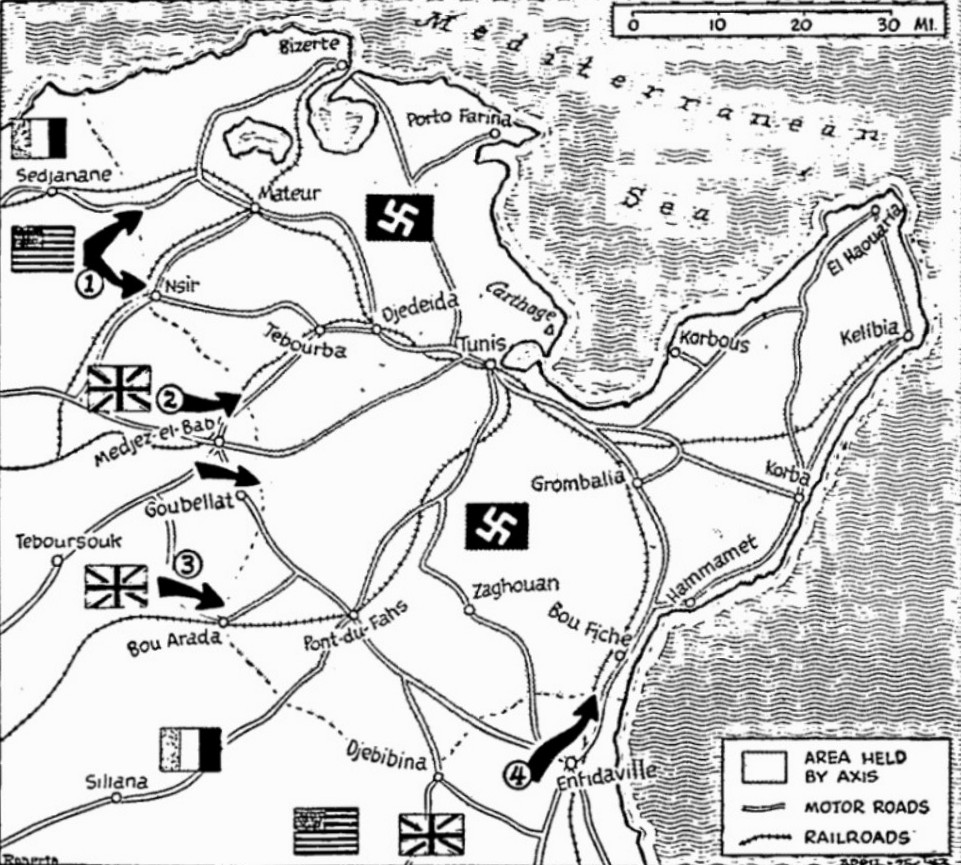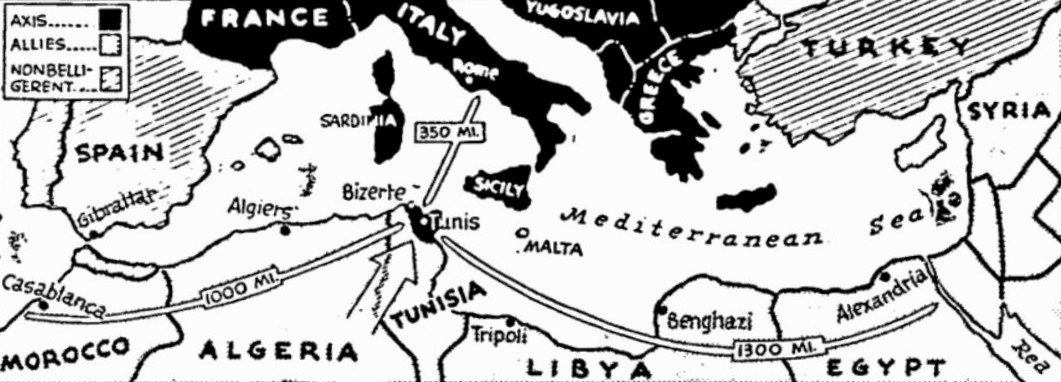The Pittsburgh Press (April 25, 1943)
Americans storm Nazi defenses in big Tunisian push
Aerial onslaught supports Allied armies driving Axis deeper into coffin corner – thousands of Yanks in battle
By Virgil Pinkley, United Press staff writer
Tunisian battle in final phase
The great attack is on in Tunisia and the fighting is growing in intensity hourly as the U.S. II Corps, the British 1st Army, 8th Army and the French Corps d’Afrique smash at the strongly-entrenched Germans on all sectors of the line defending Rommel’s coffin corner/. Developments:
1. Americans, shifted from south, gain six miles in drive toward Mateur.
2. British 1st Army captured important hill positions east of Medjez el Bab.
3. 1st Army attempts to break through enemy defenses around Bou Arada.
4. 8th Army holds gains against fierce counterattacks, pushes patrol activity.
Allied HQ, North Africa – (April 24)
U.S. forces storming into the battle of Tunisia on a new front have pushed the Germans back six miles southwest of Bizerte, while to the south, British armies advanced up to seven miles and seized key anchors of the powerful Axis defenses, the Allies disclosed today.
Tens of thousands of U.S. troops and thousands of vehicles, shifted secretly from South to North Tunisia, ripped into the German lines, capturing three dominating hills and holding them against violent counterattacks.
The all-out Allied offensive against the last Axis foothold in Africa was supported by a tremendous aerial onslaught, in which bombers and fighters flew more than 1,500 sorties and dumped the greatest tonnage of explosives ever loosed on Tunisian soil by daylight.
An official announcement revealed that the Allies had captured a German document signed by Col. Gen. Jurgen von Arnim as commander-in-chief, suggesting that Marshal Erwin Rommel had left Tunisia and saying his “present whereabouts and new appointment, if any, are unknown.”
As the Americans were lunging eastward on both sides of the Sedjenane-Mateur Road, the British 1st Army knocked out 16 German tanks, stormed and occupied most of Longstop Hill, which dominates the road to Tebourba and Tunis, and captured Goubellat in the sector southeast of Medjez el Bab.
Violent fighting rages
The British 8th Army, pounding the Afrika Korps on the southeastern coastal flank, consolidated newly-won positions some seven miles north of Enfidaville, halfway along the shore road to Bouficha.
Fighting of exceptional violence raged all along the 110-mile arc clamped against the estimated 200,000 German and Italian troops in the shrinking bridgehead.
Troops of Lt. Gen. George S. Patton’s II Corps charged into battle on the northern front at dawn Friday after their sensational transfer from the Guettar sector far to the south.
Counterattacks repulsed
At the dawn zero hour, U.S. infantrymen attacked in the rugged hills north of the road to Mateur, 20 miles southwest of Bizerte, hurling their main weight at Jebel Mrata and Jebel Aïnchouna five miles to the south.
Scrambling over the rocks through German mortar and artillery fire, the doughboys captured both hills and then withstood a series of sharp counterattacks by Nazi troops trying to wipe out the gains before the Americans could consolidate them.
South of the Mateur Road, other U.S. units stormed Jebel er Raml, a strong hill position north-northeast of Oued Zarga, and captured it. The Germans snapped back with a counterblow, supported by strong artillery fire, but failed to dislodge the triumphant Yanks.
Latest reports said the Americans had nailed down the gains carrying them within about 15 miles of Mateur on both sides of the road, but violent fighting continued in the hills, where a ceaseless rain of blows and counterblows were falling.
Quick shift from south
The U.S. advance was hailed as particularly impressive because the troops were fighting in strange country, including some of the most difficult mountain terrain in all Tunisia.
Their major attack was launched only a few days after they had completed the long move from South Tunisia. The troops of the U.S. II Corps were fighting directly under control of Gen. Sir Harold R. L. G. Alexander, deputy Allied commander, who was coordinating their operations with the British 1st Army offensive to the south.
French troops advance
Alexander, in a formal statement revealing the American shift to the north, said it involved the transfer of large numbers of troops and great quantities of stores and equipment along the whole length of the front.
Above the Americans at the extreme northern tip of the battle are the Corps francs d’Afrique was spearheading the Allied offensive. The French troops advanced in conjunction with the American drive, field reports said.
The French 19th Corps, meanwhile, was holding the hills between the British 1st and 8th Armies and maintaining heavy patrol activity.
29 miles from Tunis
Lt. Gen. K. A. N. Anderson’s 1st Army was concentrating on cleaning out stubborn German resistance on Longstop Hill, 29 miles southwest of Tunis, a position dominating the last mountain approaches.
Farther south below Medjez el Bab, British infantry seized Goubellat, after which tanks and troops burst into the plain southwest of the town against fierce opposition. They had advanced some seven miles in that area, and had occupied Crich-El-Oued, four miles northeast of Medjez.
Tank forces attack
Anderson’s advanced elements were exploiting the gains south of Medjez, hurling strong tank forces into an assault north of Sebkhet el Kourzia, a little salt lake east of the Goubellat-Bou Arada Road.
Violent armored struggles were in progress north of Sebkhet el Kourzia, the scene of the farthest 1st Army advance. A motorized enemy column was sighted south of the lake Friday. An armored squadron skirted the lake and dispersed it. From the area north of the lake, it is slightly more than 30 miles to Tunis across low, rolling ground which fades into a flat plain near the coast.

